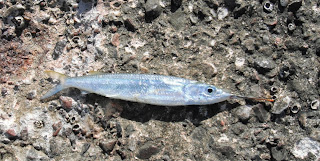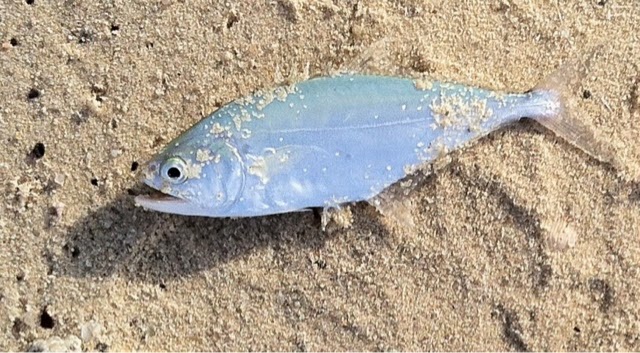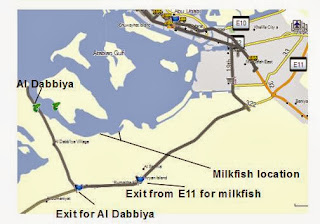This is the first site I have looked at for fly fishing in Kuwait. Access to the beach is via a alley cut through at N29 05.670 E48 08.254 near a lay-by for taxis/buses. The Sea Club is on the right of the picture (south end of the beach). I took the picture at low tide to discover underwater obstacles that would disappear as the tide came in. The picture was taken from a concrete platform in front of the building shown below.
When I did try fishing from the platform the first cast produced this Sind Half-Beak which was returned to the water.
This was caught on an orange floating fry with a flying treble. Another Half-Beak was hooked later on in the afternoon as high tide was due at 5pm. Sunset was to follow fairly closely and as I watched the beach from a nearby apartment as night fell, I noticed divers with tridents and lights entering the water to spear larger fish. This may explain the paucity of the fishing during the day. A couple of small Houndfish did launch attacks on the flies, so maybe there is hope yet of something larger.
The building has now been demolished and currently (Oct 2014) is the pile of twisted metal and rubble shown below.
The platform affords casting possibilities into the rising waters either side of the bollard above the word "Sea" in the first image, depending on the wind direction. The sand on the beach itself south of the platform is quite steep above the water line, so casting directly out from the water's edge becomes problematic.When I did try fishing from the platform the first cast produced this Sind Half-Beak which was returned to the water.
This was caught on an orange floating fry with a flying treble. Another Half-Beak was hooked later on in the afternoon as high tide was due at 5pm. Sunset was to follow fairly closely and as I watched the beach from a nearby apartment as night fell, I noticed divers with tridents and lights entering the water to spear larger fish. This may explain the paucity of the fishing during the day. A couple of small Houndfish did launch attacks on the flies, so maybe there is hope yet of something larger.
Today (7-10-14) I caught this Sind halfbeak near the large hulk (Hamek) of an old ferry opposite the demolished building beside the Sea Club premises.
On Friday 3-10-14 off the beach between these points, I caught a small queen fish on a white streamer fly.
















